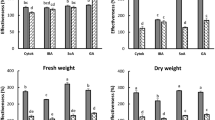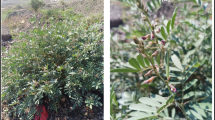Abstract
Oriental hybrid lily is of great commercial value, but it is susceptible to Fusarium disease that causes a significant loss to the production. A diploid Oriental hybrid resistant to Fusarium, Cai-74, was diploidized from triploid obtained from the offspring of tetraploid (from ‘Star Fighter’) and diploid (‘Con Amore’, ‘Acapulco’) by screening the hybrids of different cross combinations following inoculating Fusarium oxysporum to the tissue cultured plantlets in a greenhouse. By analyzing saponins content in bulbs of a number of lily genotypes with a known Fusarium resistance, it was found that the mutant Cai-74 had a much higher content of saponin than its parents. Highly resistant wild L. dauricum had the highest level (4.59mg/g), followed by the resistant Cai-74 with 4.01mg/g. The resistant OT cultivars ‘Conca d’or’ and ‘Robina’ had a higher saponins content (3.70 mg/g) and 2.83 mg/g, than the susceptible Oriental lily cultivars ‘Sorbonne’, ‘Siberia’ and ‘Tiber’. The hybrid Cai-74 had a different karyotype compared with the normal Lilium Oriental hybrid cultivars. The results suggested that Cai-74 carries a chromosomal variation correlated to Fusarium resistance. Cai-74 might be used as a genetic resource for breeding of Fusarium resistant cultivars of Oriental hybrid lilies.
Similar content being viewed by others
Article PDF
Author information
Authors and Affiliations
Corresponding author
Rights and permissions
About this article
Cite this article
Sixiang, Z., Hongzhi, W., Yan, Z. et al. Crossing Lilium Orientals of different ploidy creates Fusarium-resistant hybrid. Nat Prec (2010). https://doi.org/10.1038/npre.2010.4830.1
Received:
Accepted:
Published:
DOI: https://doi.org/10.1038/npre.2010.4830.1



